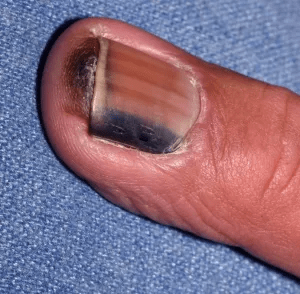- About
- Services
- Patient Information
- Specials
- Shop
- Locations
- Contact Us
A change in color, texture, or shape of your finger or toenails could be harmless, but could also reveal certain serious health issues that your dermatologist should examine for you.
They may appear yellow, purple, green, black, or white. A white or yellow nail can indicate a fungal infection of the nail (Figure 1). Nail fungus makes up 1/2 of all nail problems,[1] and nearly 14% of people are affected by it.[2] Having athlete’s foot, tight-fitting shoes, and an injured nail are some risk factors. Practicing good hygiene is key for prevention. Keep your feet dry, wear comfortable shoes, plus be mindful that saunas and hot tubs are common environments to contract nail fungus. There are many non-prescription topical anti-fungal treatments like products containing miconazole or terbinafine but often times oral prescription medications are required to adequately treat a nail.
Certain water-loving bacteria produce a green-blue pigment. When these bacteria decide your nail is a 5-star resort, it will proliferate and turn a portion of your nail green-blue. It is important to maintain dry feet to prevent it. If it occurs, soak your nail(s) in diluted vinegar. Do not use your $40 aged balsamic for this! Get your basic white vinegar and add to water to make a 1/3 ratio of vinegar/water, then soak your affected nail(s) for 15 minutes per day, 3-5 days per week, for 2 months (for fingernails) or 3-6 months (for toenails).
Any injury to a nail may cause blood to pool underneath the nail, and this appears dark purple (Figure 2). The clumsier the person, the more likely they are to experience this. What do you do if you get blood under your nail? Essentially, nothing. Only rarely these need to be drained. With that said, a professional evaluation is warranted if you have a purple nail with no recollection of a nail injury or if the nail color does not resolve even after the nail grows out (a toenail takes 9 months to grow out completely). The scary thing is that a dark-purple nail hemorrhage can look similar to a lethal skin cancer: the melanoma!
Classically, these cancers make the nail appear jet black and the discoloration will reach from the base or sides of the nail (Figure 3). Any concern for a melanoma should be brought to the attention of a dermatologist immediately, even if you have only the slightest doubt.
Figure 1. Toenail affected by fungus.

Figure 2. Fingernail affected by trauma. Blood appears purple beneath the nail.

Figure 3. Melanoma affecting the fingernail.

By Andrew Newman, DO, practicing dermatology at Honor Health/Affiliated Dermatology.
A full-service dermatology group offering services in general dermatology, skin cancer detection and treatment, Mohs surgery, aesthetics, and allergy. At our Valley-wide locations, we take pride in our dedication to help inspire and empower you to make educated, healthy decisions about skin care.
Follow Us Online:
 Scroll Up
Scroll Up